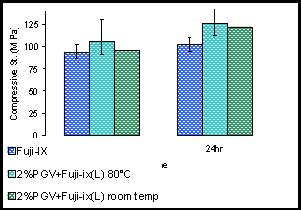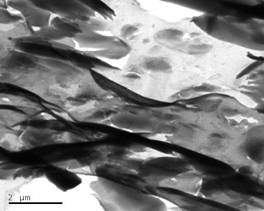ABSTRACT: 1492
Chemical and Mechanical Evolution of Glass Ionomer Clay Nanocomposites
| M.A. FAREED, and A. STAMBOULIS, University of Birmingham, United Kingdom | |
Introduction: Exfoliation of nanoclays (PGV and PGN) in Fuji-IX liquid may form glass ionomer clay nanocomposites (GCN). This study focuses on the understanding of the chemical interactions of clays with poly(acrylic acid) and their effect on the mechanical properties of the novel GCNs. Materials and Methods: PGV and PGN were characterized by X-ray diffraction (XRD) and X-ray photoemission spectroscopy (XPS) after dispersion. The chemical analysis of GCN cements was carried out by FTIR and Raman spectroscopy. TEM was performed to show the dispersion of clays in the cements. Compressive strength (CS), flexural strength (FS) and diametral tensile strength (DTS) of GCN cements were also measured. Results: The XRD showed that the interlayer distance of the silicate layers along the [001] direction was increased from 2q=12.83 to 18.34 Å in PGN where as exfoliation was found in PGV. XPS showed a disappearance of the peak associated with sodium. This peak was originally found in the XPS graph of nanoclays and the disappearance of the peak may indicate that sodium might have been replaced by the protons from the PAA solution. CS, FS and DTS testing of cements showed significant improvement in GCN based cements in comparison with the Fuji-IX control (Fig. 1). No significant changes were found in the FTIR spectra of cements with nanoclay incorporation but Raman showed a slight shift of the characteristic peaks. Finally, TEM micrographs of cements indicated the good dispersion of nanoclays (Fig. 2). Conclusion: Dispersion of nanoclays in poly(acrylic acid) solution did not affect the structure of the polymer chains as indicated by FTIR characteristic peaks. The improved mechanical properties of cements suggested that nanoclay incorporation plays an important role in the materials behavior, however further studies need to be carried out to optimize the findings of this paper.
Fig 1
Fig 2 | |
| Seq #144 - Calcium Phosphate Cements 9:00 AM-10:30 AM, Friday, July 4, 2008 Metro Toronto Convention Centre Room 803A | |
|
Back to the Dental Materials 3: Ceramic-based Materials and Cements Program | |
©Copyright 2008 American Association for Dental Research. All Rights Reserved.

